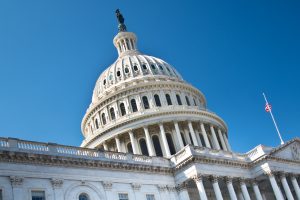 After months of deliberation, Congress passed a sweeping new $900 billion COVID relief bill on December 21. The bill, officially called the Consolidated Appropriations Act 2021, H.R. 133, was signed into law by President Trump on December 27, thereby enacting numerous measures designed to provide financial assistance for individuals and businesses impacted by the ongoing pandemic. For commercial building owners and the primary designers of qualifying energy efficiency measures in public buildings, the new spending package contains an exciting and long-awaited change: it permanently adds the §179D deduction to the tax code. Previously, the deduction was considered a “tax extender” and had been due to expire at the end of 2020.
After months of deliberation, Congress passed a sweeping new $900 billion COVID relief bill on December 21. The bill, officially called the Consolidated Appropriations Act 2021, H.R. 133, was signed into law by President Trump on December 27, thereby enacting numerous measures designed to provide financial assistance for individuals and businesses impacted by the ongoing pandemic. For commercial building owners and the primary designers of qualifying energy efficiency measures in public buildings, the new spending package contains an exciting and long-awaited change: it permanently adds the §179D deduction to the tax code. Previously, the deduction was considered a “tax extender” and had been due to expire at the end of 2020.
What is the §179D deduction?
Created under the Energy Policy Act of 2005 (EPAct) with a goal of incentivizing commercial building owners to reduce energy consumption, §179D of the tax code offers a deduction of up to $1.80 per square foot for qualifying energy efficiency measures installed in new or existing buildings. Specifically, the deduction is worth up to $0.60 per square foot each for improvements to a building’s interior lighting systems, HVAC and hot water systems, and the building envelope. Under the new law, these amounts will be indexed for inflation—representing an expanded opportunity for eligible taxpayers to minimize their tax burdens going forward.
The §179D deduction is available to commercial building owners who install qualifying energy efficiency measures. In addition, primary designers—including architects, engineers, contractors, and green building consultants—may be entitled to the deduction when they design qualifying measures for government-owned buildings, such as schools, libraries, or transportation facilities. Since government entities are tax-exempt and therefore have no use for the §179D deduction, they may allocate it to the primary designers.
To qualify for §179D, projects must be certified by a third party—such as Capital Review Group—using IRS-approved software to ensure that the energy efficiency measures installed satisfy the applicable ASHRAE Standards. Previously, this was ASHRAE 90.1-2007, but under the new law, projects must meet the requirements of the most recent standard as of two years before the start of construction.
Other relief measures for businesses
The new COVID relief package extends and/or expands several provisions of the CARES Act, including the following:
- Additional Paycheck Protection Program (PPP) loans. One of the most powerful relief measures for businesses under the CARES Act is the PPP, which allows certain businesses with fewer than 300 employees to take out loans that may be forgiven if they retain their entire workforce. The new law includes a second round of PPP loans and expands the list of qualified expenses for which the funds may be used to include certain operations expenses, supplier costs, property damages, and personal protection equipment. In addition, Congress clarified that businesses may take deductions for otherwise deductible expenses paid with PPP loans.
- Significant expansion of the employee retention tax credit. Another way that the CARES Act tried to incentivize businesses to retain their employees was by providing a refundable payroll tax credit of 50 percent of wages paid between March 13, 2020 and the end of the year, up to $10,000 per eligible employee. The new relief package extends the credit for wages paid through June 30, 2021 and expands it in several ways. For example, the credit rate is now 70 (versus 50) percent of qualified wages, the limit on the per-employee wages that may be eligible for the credit has increased from $10,000 for the year to $10,000 per quarter, and businesses that were not in existence for all or part of 2019 may now be eligible for the credit.
- Extension of payroll tax deferral. The CARES Act allowed businesses to delay paying their share of Social Security taxes and repay the amounts via additional withholding between January 1 and April 30, 2021. The new law extends this time period by allowing deferred tax to be repaid throughout 2021.
The new relief package includes several other provisions relevant to businesses, such as five-year extensions of the Work Opportunity Tax Credit (WOTC), the New Markets Tax Credit, the employer credit for paid family and medical leave, and other incentives that are not permanent parts of the tax code. In addition, businesses may now take a 100 percent deduction for business-related meals (as opposed to the current rate of 50 percent) through 2022.
With new opportunities to reduce their tax burdens, businesses—and particularly commercial building owners and designers who may be eligible for the §179D deduction—should consult their tax professionals to determine which strategies may be available to them. At Capital Review Group, our team offers a unique combination of expertise in tax, engineering, and commercial real estate, enabling us to help our clients maximize their savings through the §179D deduction, Cost Segregation, and other powerful tax strategies. Contact us today to schedule a consultation!